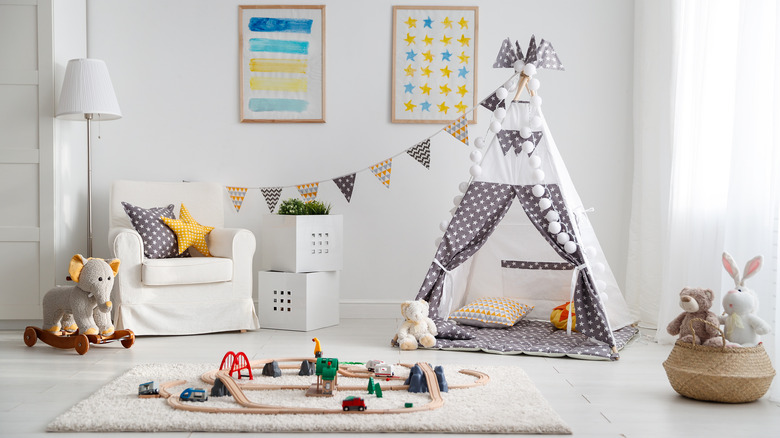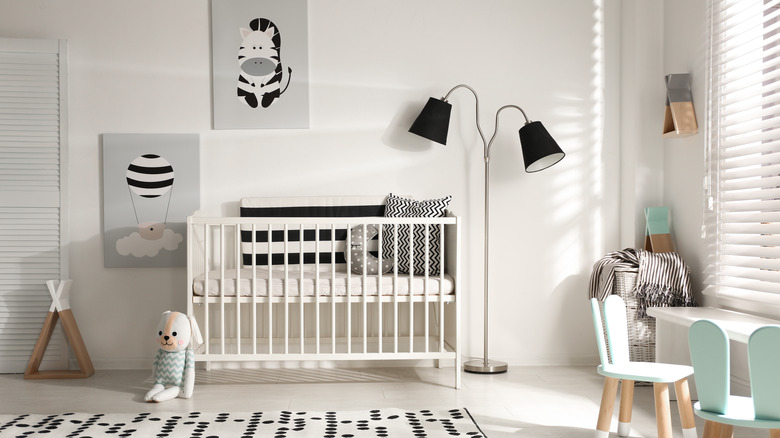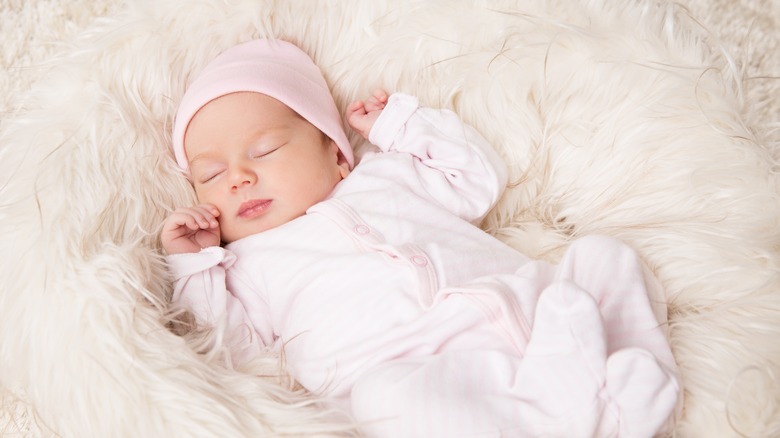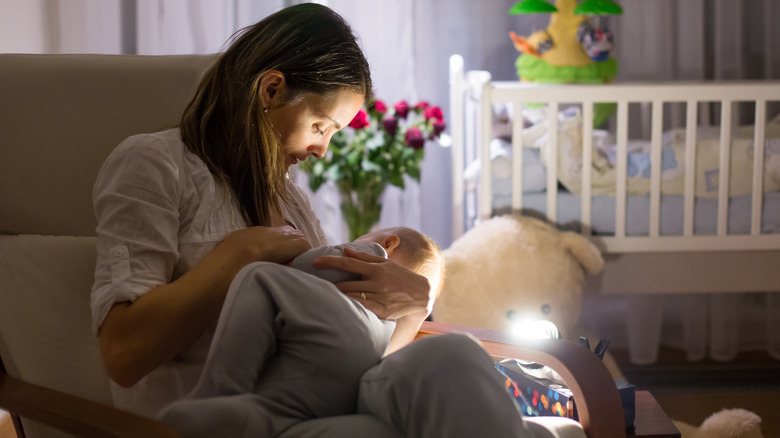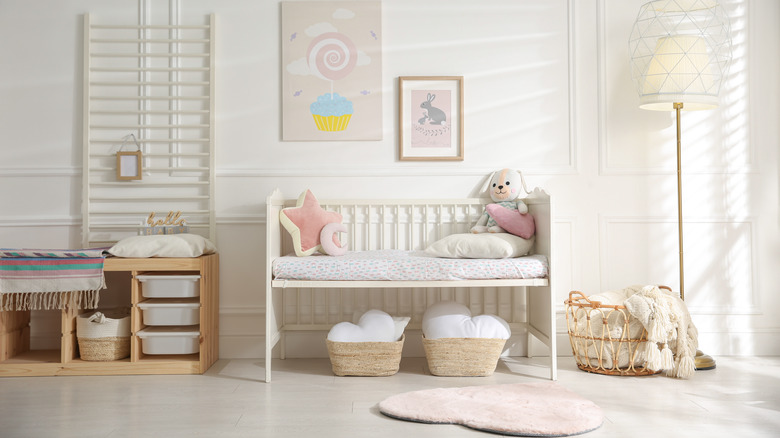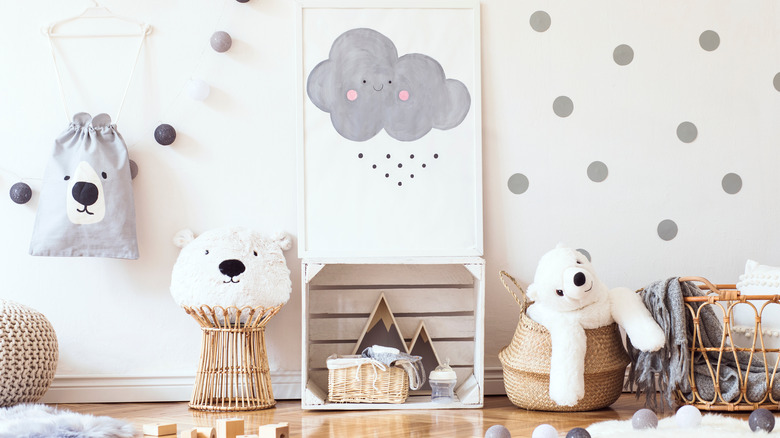The Best Way To Design A Baby's Nursery, According To An Expert
During the first year of life, a baby's vision improves, they learn to explore the world around them by reaching out and touching things, and they start to learn to play. In addition, many parents know the importance of spending time reading to their baby and talking to them in order to encourage communication skills — all of which are important developmental steps during this critical time, according to the U.S. Centers for Disease Control and Prevention.
Their environment, then, plays a big role in the child's overall ability to grow and flourish. To that end, Karen Aronian, Ed.D., Education Design Expert and founder of Aronian Education Design LLC, shares some insight into creating a positive environment in an exclusive interview with House Digest. "I design nurseries with eye stim in mind. This environment is ideal to optimize a newborn baby's development," she shares. "My work intentionally includes education design foundation principles based on a child's development milestones."
Strategically working with color
A new baby's vision isn't fully developed when they first come home to their new nursery, but their environment can help to stimulate and support eyesight improvement as well as overall perception if designed well. Color can be a big part of this, and in several ways, as noted by Dr. Aronian. "I start with black and white contrast, progress to primary colors, and continue to consult with families as a child grows," she explains. "I weave in specific colors, cognitive as well as personalized elements that are child- and family-dependent."
Various hues can both contribute to and create the best atmosphere for the newborn in various ways. "Additionally, I include calm color zones within the nursery for restorative sleep and mind and body regulation," Dr. Aronian continues. Just as most parents appreciate a calming space after a long day, young children may benefit in the same way. Soft shades surrounding a crib, for example, may help lull the baby to sleep. So choose the best colors for a baby's nursery based on these factors.
Incorporating the right textures
Don't just stop at color when creating your baby's nursery — also consider what the child can feel and experience through touch in the space around them. "Exposing infants to different textures, fabrics, and stimuli will aid in their sensory processing development and inform their understanding of their surroundings," Dr. Aronian reveals. "Sensorial multi-textured elements are important to implement when designing for a baby's uptake and regulation. These elements imprint an understanding of touch and foster a rich vocabulary related to the senses."
Don't overthink it when trying to bring in these textures, either. Instead, consider Dr. Aronian's recommendations. "Different textured bedding, playthings, furnishings, and surfaces can provide a variety of necessary stim inputs (silky, fluffy, nubby, squishy, slippery, grainy, bumpy, rough, smooth) for little ones' systems," she continues. "It is also vital to engage a child's vestibular (body's relation to movement, balance, and gravity) and proprioception (strength employed in movement and body position in space) as they grow." With this variety of sensory experiences, a child touches, learns, and develops each day.
Customize the lighting
It's easy to overlook a nursery's lighting, but customizing it encourages and supports a baby's needs. "A room's color and brightness signal the mind and body for action or rest activities such as naptime and playtime," Dr. Aronian notes. "An overhead central light fixture on a dimmer will bathe the space in the ideal glow throughout daily activities."
Consider other options aside from simple bright, white options, too. "LED bulbs emit the best light as you read, feed, or lullaby," Dr. Aronian continues. "Adding colored LED lights can offer fun, social media-worthy aesthetics to celebrate holidays and milestones and serve as visual activity cues." Note that you can experiment with different settings and products to achieve the best results.
At its core lighting is functional and, therefore, also should be where you need to see well. "I prefer a flexible clip-on light for the changing table to direct light to the task and keep light at bay for a baby's potential back-to-sleep slumber," Dr. Aronian adds. "Lastly, a small stand-alone light beside, behind, or overhead of a rocker is ideal for feeding, nursing, rocking, and reading."
Bring in the right furniture
While picking a beautiful, curated furniture set may seem like the easiest option for your nursery, there are a few careful decisions parents need to think about, according to Dr. Aronian. "Critical considerations for nursery furniture are eco-friendly, durable, and wellness design," she points out. "The different stages of nursery furnishing transition quickly during the first year. Repurposed, gently used furnishings can be short-term workhorses to be shared and passed on."
Consider all options with a keen eye on what's actually needed in the space, too. "Questions to consider regarding furniture are where the baby will sleep, be changed, and have playtime and downtime," Aronian advises. "Further still, where to keep the clothing, mementos, playthings, books, music, and monitors."
As you work to design the baby's room, think about all the items that are essential in that space as well. "Window shades and door coverings are important for privacy and to block light," Dr. Aronian continues. "Baby monitors, air filters, and sound machines are also good investments for the nursery." However, don't just select what's cute or the right color. "Choose paint, wall, and furniture materials that are sustainable and certified non-toxic," Dr. Aronian adds.
Incorporate purposeful artwork
Many parents focus on these finishing elements as final touches, sometimes bringing together unrelated cute finds they think are too adorable not to include without rhyme or reason. There's more to the design than that, though, per Dr. Aronian. "Artwork need not be expensive; however, art with meaning will showcase the love and intentionality of a personalized nursery," she explains.
To make it your own, be sure to think about both your baby and your interests. "For example, a baby's name incorporated into a hand-stitched sampler by grandma says it all," Dr. Aronian continues. "Framed mantras, early childhood learning (ABCs, shapes, numbers), eye-stim art, family photographs, and sibling artwork are ideal pieces to spotlight, display, and rotate."
Dr. Aronian also recommends looking around for items you may already have that can contribute. "Hanging and exhibiting family mementos, heirlooms, framed cards, illustrated books, and baby presents creates the perfect décor," she concludes. "A cosmic mural spray painted onto the ceiling is a dynamic learning fit for years to come." And how fun is that?
